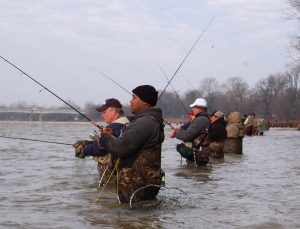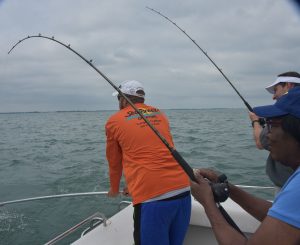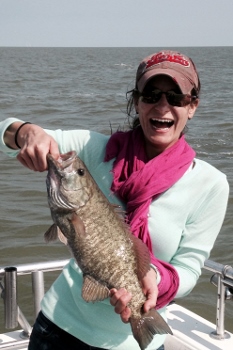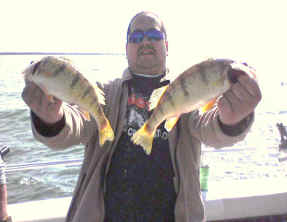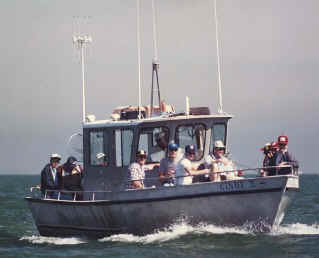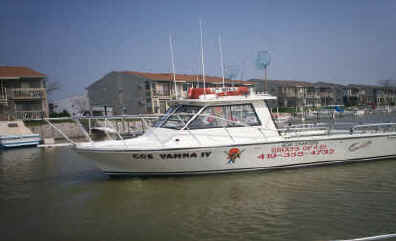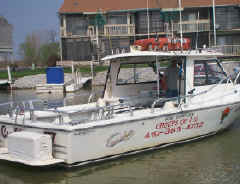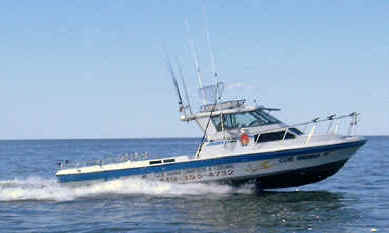Walleye Fishing Out Look
2024
As walleye soar to record levels, anglers, charter captains, and tourism officials are thrilled

“Based on these results, anglers can continue to expect many years of remarkable walleye fishing,” ODNR Division of Wildlife Chief Kendra Wecker said. “The Walleye Capital of the World will have great fishing for years to come thanks to another favorable hatch.”

Anglers can expect great walleye fishing in Lake Erie to continue following another exceptional hatch in 2023.
Although the yellow perch hatch was below the long-term average, anglers in the western basin of Lake Erie can expect some seasonally good fishing for yellow perch during the summer of 2024.
Data from annual trawl surveys conducted by the Division of Wildlife are combined with those collected by the Ontario Ministry of Natural Resources and Forestry to indicate the combined success of spawning and early life survival of walleye and yellow perch in the western basin. In the central basin, Ohio’s trawls are used in conjunction with other agency surveys to gauge hatch success.
Results allow biologists to estimate how many young fish will enter the catchable population two years later. These indices are a key piece of information used by the inter-agency Lake Erie Committee of the Great Lakes Fishery Commission to determine annual levels of safe harvest for walleye and yellow perch.
Walleye
In an unprecedented run of great walleye hatches, four of the survey’s top five hatches have occurred during the past six years. The 2023 western basin walleye hatch index was 132 fish per hectare (a standard measure of catch per area), well above the average of 56, the fifth largest in the survey’s 36-year history.
The walleye population in Lake Erie has exploded during the past few years — the fishing is considered to be great, and fisheries managers say it will only get better every year as younger fish grow. There are now big numbers of 5 and 6 year old walleye 20 to 26 inch!
“We just had, based on our trawl survey, the best hatch we’ve ever seen,” said Travis Hartman, Lake Erie administrator at the Ohio Division of Wildlife’s Sandusky Research Station. “We’re very pleased.”
Thousands of anglers migrate to the Maumee and Sandusky rivers for the annual spawn, Photo by James Proffitt
For better than a decade, the 2003 walleye hatch has been the legendary hallmark. And while the 2015 hatch was huge, it didn’t approach 2003 numbers. The next year’s 2016 hatch was mediocre, but then 2017’s walleye hatch was pretty good. But the 2018 hatch? The bar graph could be enough to make any angler (or fisheries biologist) swoon. Its been above average to near record hatches 2019, 2020 and 2021!
While the Ohio Division of Wildlife has released its survey results, officials with their northern counterparts haven’t yet publicly released their trawl surveys. The combined figures will likely be finalized in late February or early March. But word on the street – or rather, on the water – is that when combined, the numbers will definitely surpass the 2003 record.
Where do walleye spawn, and when?
Walleye spawn when water temperatures rise above 40 degrees, usually in late March or early April. They often spawn in shallower waters, such as bays and rivers like the Sandusky and Maumee.
Gravelly, sandy or rocky bottoms are ideal sites for females to broadcast eggs – up to 400,000. But the majority of Lake Erie walleye actually end up spawning on shallow reefs and nearshore waters in the lake proper, where males follow quickly behind egg-spreading females, eager to spread their love, too. Walleye tend to return to the sites where they were hatched to spawn.
Once eggs are fertilized and larval walleye develop on their spawning beds they’ve only a short window to make it or die, Hartman explained. After just a little more than a week when they are self-feeding, still inside tiny yolk sacs, they bust out. And they’re hungry.
“They need zooplankton (microscopic organisms) to eat and to survive. Right after they hatch from the sacs,” Hartman said. “But they need food and need it where they are right away.” If the zooplankton aren’t there, the tiny fish are doomed
Can wildlife managers influence the walleye population?
No one has much control over zooplankton or walleye in Lake Erie’s roughly 10,000 square miles. The only control fisheries managers have over walleye populations, Hartman said, is harvest limits. Those levels, he said, have only been tweaked minimally in recent decades.
Prior to 2001, the limit had been 10 fish per angler per day, all year long. But biologists then realized the given walleye population couldn’t support such creel limits. “It was definitely reflective of the population,” Hartman said. “Things were looking pretty bleak at the time.”
It was then Ohio Division of Wildlife managers decided to cut the daily limit, per angler, to six fish. And they cut the limit even further during the spring spawning period, to just four fish per day. While anglers in general weren’t necessarily happy, they knew it was for the best.
During some years the hatch has been virtually non-existent. In 2002 and 2004, the trawl netted virtually no new walleye. The one trend that has caught biologists’ attention is that colder winters, especially those with significant ice coverage in the Western Basin, seem to help the hatch.
While the term “hatch” is applied regularly to trawl survey results, it may not be exactly accurate, Hartman said. That’s because the number of walleye that hatch could never be counted, since they’re too tiny to be counted.
What fisheries managers are really counting and calculating through trawls is the number of walleye that survived the spring and summer and made it to the lake. Those fish are termed young-of-year, and they’re the ones counted annually when they get scooped up in the scientific sampling.
Long-time charter captains have seen it all
Mel Fenger has been a charter captain on the lake’s Western Basin for more than three decades and has seen the ups-and-downs in walleye populations. He began taking folks fishing just when things got really good.
“It was about 1985, just three years after the 1982 hatch,” he explained. “We were catching fish from the third year of that hatch.” (for decades, the minimum size limit for ‘eyes has been 15 inches, which is the size they reach in their third year) “It went along there great into the 1990s,” Fenger explained. “Then it began to slow and you could see a definite change.”
Fenger’s correct, walleye fishing was slow for some years. And then came the 2003 hatch. And once again, three years later the fishing took off. Those fish from the 2003 hatch are now massive trophy fish measuring 25 inches or more. “That was great,” he said. “But after that there were some years where there was little to no hatch.”
Then in 2013 and 2014 there were good hatches, and 2015 was great, Fenger said. Fast-forward to 2018 and there was what many considered really great fishing.
“The future is bright,” he said. “For all the younger charter captains I think it’s going to be a real blessing.”
Walleye are Lake Erie’s economic engine
With 700-plus charter boats operating on Lake Erie, the vast majority in the Western Basin, charter fishing is big business on the lake. And walleye – the big-eyed, toothy predators – are target No. 1.
Ohio Division of Wildlife statistics indicate that between charter and private boats, nearly 700,000 fishing trips take place on the lake each year on Ohio waters. Add a couple hundred thousand for Michigan, Ontario, Pennsylvania and New York. Estimates of Ohio’s Lake Erie sportfishing and associated expenditures, which include bass and yellow perch efforts, top $1 billion annually.
That’s music to the ears of Larry Fletcher, president of Lake Erie Shores & Islands, who is tasked with promoting tourism in Ottawa and Erie counties at the western end of Ohio’s lakeshore.
“We don’t consider these numbers an invasion,” Fletcher said about the massive influx of new fish. “We want the walleye. I don’t think we’ll ever find a time when there are too many walleye in the lake.”
According to Fletcher, he was happy when he got wind of the 2015 hatch. “And now we get word that this 2018 hatch rivals both of these, and is likely even better,” he said. “They don’t call this The Walleye Capital of the World for nothing.”
(Full disclosure: Baudette, Garrison, Isle, Ray, and Rush City, Minn., Garrison, North Dakota, Umatilla, Ore., Mobridge, South Dakota, and Shell Lake, Wisc. also claim to be “The Walleye Capital of the World.)
Fletcher said people from all over the nation travel to fish Lake Erie. “It’s the go-to place for walleye. In the spring we get anglers from Wisconsin, North Dakota, South Dakota, Iowa, Illinois, New York, Pennsylvania – you name it.”
In addition to charters and everyday anglers, the lake’s walleye population also draws tournaments which attracts hundreds of out-of-state anglers and plenty of news coverage each year. All great for the economy, Fletcher said, and Lake Erie’s reputation as the true Walleye Capital of the World. And he emphasized the word “true” with a steady conviction.
How do biologists know how many walleye there are?
Each year, fisheries managers in Ontario and Ohio get together to figure out how many new walleye there are in Lake Erie. They use bottom trawls to check out how many tiny walleye they pull from the lake’s bottom. They target, in late summer and early autumn, the fish that hatched earlier in spring.
“In the trawls, nets get dropped to the lake’s bottom for 10 minutes,” Hartman explained. “Slowly, boats move along for 10 minutes, then pull the nets.” The current trawl survey model has been used since 1987,” he said.
The Division of Wildlife’s 2018 trawl found 112 walleye per hectare (about 2.5 acres.) That’s the second-highest number on record and far above the 20-year average of 27 walleye per hectare in Ohio waters. Ohio biologists conduct about 40 trawls in the Western Basin.
Initial reports from trawls conducted by the Ontario Ministry of Natural Resources & Forestry in Ontario waters showed similar results. In fact, Richard Drouin, lead management biologist with OMNRF, said they’re more than happy with the results.
“Walleye numbers for us based on our survey are at an all-time high,” he said. “We sampled 36 sites on our side and we use the same protocol as Ohio.”
Fisheries managers with Ontario and the other Lake Erie states will meet in late winter to set the total allowable catch for the next season. For Canada, that means mostly commercial fishermen will pull ‘eyes form the lake. “Our sport angling fishery is nowhere near the size of Ohio’s,” Drouin said.
In Ohio commercial netting of walleye is prohibited – walleye are taken only by hook and line anglers.
Drouin said biologists are especially pleased because numbers have been high for multiple years. “It’s been a long time since we have had re-occurring recruitment from the spawns,” he said, going on to explain that it offers anglers and commercial fishermen a steady stream of catchable fish. “I think what we’re looking at here is a really healthy population of walleye and it should provide good fishing for years to come. I wish we could take credit for it but it was all Mother Nature.”
Based on models of the combined research efforts, Hartman speculated, there could be a population of 130 million walleye in the lake. Or more.
Anglers catching more fish than they used to
Fenger said he’s trolled, though rarely. Trolling is a technique where rods are set on a boat that moves very slowly, usually between 1 and 2 mph, and baits are pulled behind. Sometimes a boat carrying six passengers could have 12 or 14 lines in the water at one time. Anglers grab a rod and reel it in once a fish is hooked.
“These days that’s the dominate technique,” Hartman said. “As a group, we’re getting better at catching fish.” Hartman said trolling has become more popular in the last couple decades because in general, more fish can be hooked and netted using the technique. Twice as many rods can be used and more water is covered. And most anglers on the lake are trolling nowadays.
But that’s okay, he explained. The lake’s walleye population is exceptional and if anglers get really, really too good at landing walleye and the population declines significantly, science (and scientists) will simply adjust the creel limits to protect populations. Although that doesn’t look like it will be happening anytime soon. Recent hatches will provide catchable walleye for the next decade.
“I’m old school,” Fenger said, and most of his customers are, too. “We like to drift and cast. Most of my customers like to have a fishing rod in their hands the whole time.”
Catching the maximum amount of fish allowed by law isn’t really that important, he said. “The number of fish isn’t the hallmark of a good charter,” Fenger explained. “Most of my customers have been with me for 15 years or more, some of them for 30. Catching a limit puts real whipped cream on top of the sundae. But the real winner is being out on the lake fishing, setting the hook and having a ball.”
Lake Erie 2019 Walleye Fishing like The Good Ole Days
PORT CLINTON — We all love to talk about the glory days and recall with excitement those snapshots off the calendar we consider the best of times. We relish the memories and relive those periods when it seemed like the planets were perfectly aligned, the sun always was shining, the fish were biting, and the harvest was overwhelming.
Usually, the predominant thought is it was a rare phenomenon, and we never will experience such exhilaration again, or live to see another sequence of such unlimited excellence. But that might not be the case for those anglers that make Lake Erie their home turf and walleye their fish of choice.
In recent years, when Erie’s walleye fishermen would harken back to the bounty of fish they encountered during the walleye boom of the 1980s and 1990s, they would speak wistfully, as if that explosion of fish was a one-time event, sparked by the ban on commercial fishing for walleye in Ohio waters put in place in the late 1970s.
Now, those same anglers are looking for a repeat — another walleye gold rush — and they see it out there on the horizon.
“The good old days start this year,” exclaimed charter captain Eric H. “The future of walleye fishing in Lake Erie for the next five to seven years is going to be fantastic!”
The reason for that unbridled optimism, an enthusiastic opinion shared by many, is most of the fish from a couple of outstanding hatches in recent years have now matured into “keeper” size walleye at 15-inches or more in length. While many anglers were temporarily frustrated by all of the small fish in the catch this past summer — there were days where boats went through 100 walleye hook-ups just to see 20 legal-size fish — their frustrations should transform into coolers full of satisfaction in 2018, and beyond.
“We saw definitive proof about a really bright future,” said Hirzel.
Toledo native and walleye pro-Ross Robertson had to chuckle this past season each time he heard about the “problem” with all of those small fish out in the lake, knowing what was just around the corner as those young fish fed aggressively and grew quickly.
“Those fish are now 16-to-17 inches long, and according to state, there was more than 100 million of them, just in the 2015 hatch alone,” “Most of those throwbacks are now all legal. I think the good problem we will have now is catching the trophy-size fish Lake Erie is known for, with all of these Erie-size ‘eaters’ we now have out there.”
Travis Hartman, who makes monitoring and preserving world-class fishery his life’s work as the Lake Erie Program Administrator for the Ohio Division of Wildlife, said the 2015 walleye hatch is one of the largest ever studied.
“This year’s 2-year-olds started out mostly under the 15-inch size limit and by the end of the season many of them were ‘legal.’ Our angler walleye catch rates were the highest we’ve seen in decades … so moving forward the walleye outlook is fantastic,” said Hartman, who estimated with so many smaller fish in the lake, around 2 million walleye were released this past season, and about 1 million walleye were harvested.
Captain Mike McCroskey said the volume of fish in the lake’s Western Basin this past year often reminded him of those 100-walleye-a-day times from decades ago. Seeing the incredibly bright future that all of those small fish represented, McCroskey is beyond optimistic about what lies ahead.
“Yes, we were measuring fish all day this past year, but in 2018 they will all be keepers. Those young walleyes were hungry, and once they get some weight on them, we should once again have 100-pound boxes of fish,” he said, referring to a six-man charter party with a hefty limit catch. “The whole bottom of the lake is covered in walleyes.”
Hartman said the robust walleye class of 2003 will continue to provide most of the true trophy fish, but other strong hatch groups in 2007 and 2010, plus the outstanding hatches in 2014 and 2015, will give the lake a veritable smorgasbord for walleye anglers.
“Consistent walleye fishing success in the Western Basin is dependent on having good numbers of young fish in the system, and there will be plenty in the foreseeable future,” Hartman said. “When you consider the now-trophy-sized 2003 year class, and also strong 2007 and 2010 classes, I would argue that we have the best mix of trophy potential and total numbers of fish that we have seen since the 1980’s and early 1990’s.”
Dedicated walleye angler Jim Gracyk shares that bright outlook. “The walleye bite should be lights-out from early spring all the way through next year’s first ice,” Gracyk said. “Those 14-inch fish that we were releasing all summer will be great 18-inch keepers. The few remaining 2003 hatch walleyes might produce the next 15-pounder.”
Captain Dave Spangler constantly had to remind the Lake Erie anglers any frustration they experienced with those under-sized walleye in 2017 would be wiped away with the bounty the lake will produce in the coming years.
“Just think about catching 100 walleye a day, day after day,” he said. “No matter what the size of those fish might be, there’s no place else on the planet where you can do that but here on Lake Erie. And those small fish will all be legal keepers in 2018.”
The bonus that came along with the brisk walleye action this past year was an active and productive yellow perch fishery.
“I have been perchin’ since 1968, and this year the perch fishing was the best I’ve seen since then,” McCroskey said.
“Fall perch catch rates were very good, and the grade of fish was the best we have seen in the Western Basin in decades,” Hartman added.
Spangler, another veteran of many seasons on the lake, concurred. “The late-season perch fishing in the Western Basin was again fantastic, with limit catches the rule, even with the lack of shiners,” he said. “The size was also impressive, with 9, 10, 11, and 12-inch fish in the cooler. After four-plus years in a row of good hatches, the next five years should be great as well
Ohio may try to restore sport fish to Lake Erie
PORT CLINTON, Ohio (AP) — Ohio’s wildlife agency is studying whether to make another attempt at bringing back a sport fish that disappeared many decades ago from Lake Erie and rivers in northern Ohio.
Researchers plan on using DNA to determine whether sauger could be restored to the lake and the rivers that flow into it.
Sauger disappeared from the area in the 1950s because of overfishing and habitat loss. It’s often compared with the walleye, one of Lake Erie’s most popular sport fish.
The state’s natural resources department stocked sauger from the Missouri River in Lake Erie for three years during the 1970s, but it didn’t work, said Jeff Tyson, the department’s Lake Erie fish management program administrator.
The Missouri River fish came from a different climate and habitat and may not have been able to adjust, he said.
“We’re essentially going back and doing the same thing, but trying to cross off some of those reasons why it didn’t take,” he told the Port Clinton News-Herald .
Wildlife officials think sauger that has similar DNA to the ones that once lived in Lake Erie would have a better chance of adapting and surviving in the lake.
The state is working with the U.S. Geological Survey in Ann Arbor, Mich., to test populations of sauger. They’re considering Lake Ontario sauger from the St. Lawrence Seaway, Ohio River sauger and ones from a Minnesota lake.
Lake Ontario has the only known population of the sauger in the Great Lakes, Tyson said.
“Hopefully, in the next year, we’ll have an idea,” he said.
Restoring sauger would help balance the food chain, Tyson said. They eat small fish like emerald shiners and gizzard shad.
Sauger usually grow to 15 inches, but can reach 24. They mostly stay in the warmer near-shore water and turbid water.

